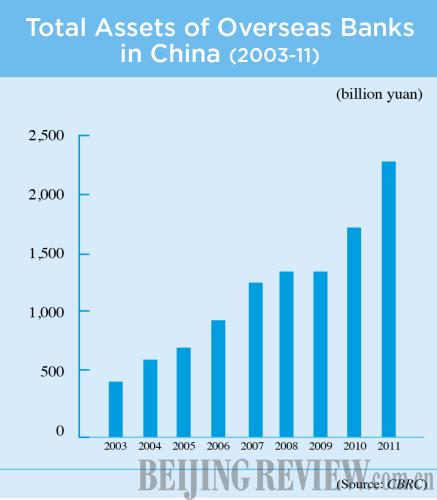|
 |
|
AMBITIOUS INVESTOR: A pedestrian passes by the Shanghai Branch of Australia & New Zealand Banking Group Ltd., Australia's third-largest lender. This May it announced a new investment plan totaling 2 billion yuan ($317 million) in China (CFP) |
Like most industries, talent remains a major challenge for overseas banks—so much so that more than half of the survey respondents believe talent shortage would have a "significant" or "very significant" impact on their top-line growth.
While the European banking sector was cutting jobs last year, China's banking industry, especially overseas banks, were hungry for talent as a result of fast expansion, said Ye A'ci, the Human Resources Director of Standard Chartered China. Standard Chartered Bank has doubled the number of its China staff from about 2,000 in 2006 to the present 4,000.
Although overseas banks pulled through understaffing via poaching from local banks by providing higher salaries in earlier years, the problem has reemerged with their further expansion in China and the continued growth of the whole financial sector.
According to the PwC report, the difficulty score for finding and keeping good personnel rose again this year following a trend in 2009.
"The pay rise in local banks has made it difficult to lure talent away from their fast-growing local competitors," said the Securities Times.
Facing a talent shortage, many overseas banks are on an aggressive recruitment drive, aiming to increase the industry's head count by 56 percent to 55,000 by 2015 from the current 35,000.
As in past years, the strict regulatory environment continues to be a major concern to the 41 overseas banks surveyed. On the respondents' wish list of key regulatory restrictions, they would like to see relaxed loan-to-deposit ratio cap, bond underwriting, access to the derivatives market and the wealth management market, a higher quota of offshore funding, and equal treatment on QDII. On a surprising note, the participants surveyed consider CBRC a more supportive regulator than even their own home regulators.
China requires local units of overseas banks to keep their ratio of loans to deposits to 75 percent, the same as local lenders. The cap isn't much of a constraint on local banks thanks to their huge deposit bases, but is a hindrance for overseas banks to expand their lending business.
"Overseas banks have been affected by the 75-percent loan-to-deposit ratio. Their deposits are difficult to generate in the absence of an extensive branch network," said the PwC report.

Email us at: liuxinlian@bjreview.com | 